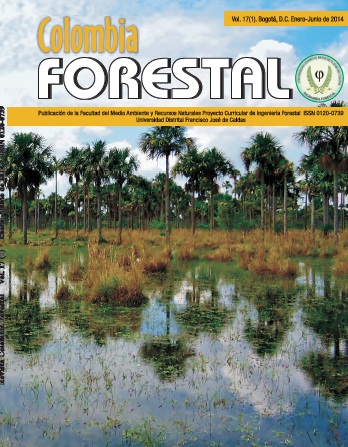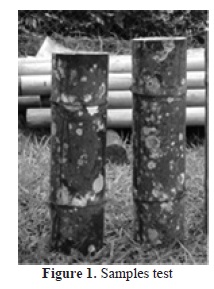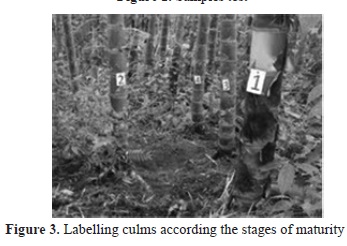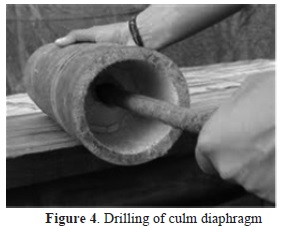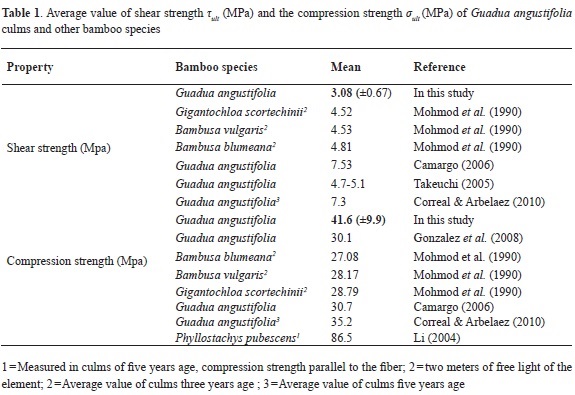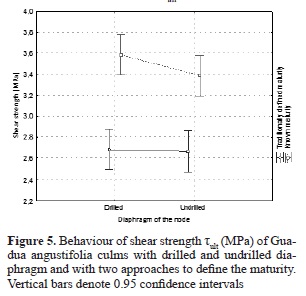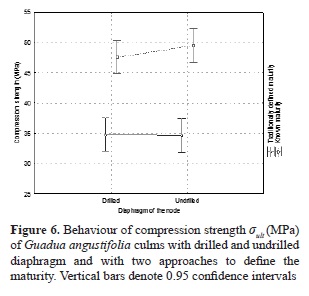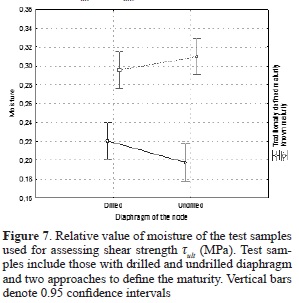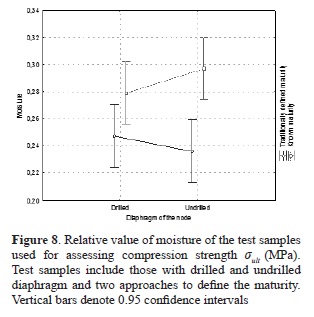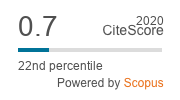DOI:
https://doi.org/10.14483/udistrital.jour.colomb.for.2014.1.a07Publicado:
01-01-2014Número:
Vol. 17 Núm. 1 (2014): Enero-JunioSección:
Artículos de investigación científica y tecnológicaCompression resistance and shear strength of Guadua angustiolia culms after drilling of the node diaphragm
Resistencia a la compresión y al corte de culmos de Guadua angustifolia después de la perforación del diafragma del nudo
Palabras clave:
absorción, bambú, boro y ácido bórico, culmos comerciales, preservación, madurez, humedad (en).Descargas
Referencias
Bhatt, B.P., Singha, L.B., Singh, K., & Sachan, M.S. (2003). Some commercial edible bamboo species of North East India: Production, indigenous uses, cost-benefit and management strategies bamboo science and culture. The Journal of the American Bamboo Society, 17 (1), 4-20.
Camargo, J. C. (2006). Growth and productivity of the bamboo species Guadua angustifolia Kunth in the Coffee Region of Colombia (Ph.D. Tesis). Göttingen: Göttingen Universität. 205 p.
Correal, J.F., & Arbeláez, J.( 2010). Influence of age and height position on Colombian Guadua angustifolia bamboo mechanical properties. Maderas: Ciencia y Tecnología, 12 (2), 105-113.
González, H.A., Montoya, J.A., & Bedoya, J.R. (2008). Comportamiento de muestras de Guadua angustifolia kunth con diafragma y sin diafragma sometidas a esfuerzo de compresión. Scientia et Technica, 38, 449-454.
Gritsch, C., Abranson, K., Camayo, G., Rashid, M., Murphy, R., Londoño, X., & Camargo, J.C. (2004). Anatomical culm analysis of Guadua angustifolia in relation to age, site, and physico-mechanical properties. In Proceedings International Symposium Guadua 2004. Pereira, Colombia.
Henao, E., & Rodríguez, J.A. (2010). Cambios en las propiedades físico-mecánicas de culmos de Guadua angustifolia como indicadores del estado de madurez. Revista Recursos Naturales y Ambiente, 61, 19-26.
Hisham, H. N., Othman, S., Rokiah, H., Abd Latif, M., Anil, S., & Mohd Tamizi, M. (2006). Characterization of bamboo Gigantochloa scortechinii at different ages. Journal of Tropical Forest Science, 18 (4), 236-242.
I
SO/TR 22157-1. (2004). Bamboo. Determination of physical and mechanical properties. Part 1: Requirements. Geneva: ISO. 19p
Li, X. (2004). Physical, chemical, and mechanical properties of bamboo and its utilization potential for fiberboard manufacturing (Master Thesis). Louisiana: Louisiana State University, Agriculture and Mechanical College, 76 p.
Liese, W. (2004). Structures of a bamboo culm affecting its utilization. INBAR Intern. Workshop “Bamboo Industrial Development” Xianning, 12. 11. 2003 Proc. 2004, 1-8
Liese, W. (1998). The anatomy of bamboo culms. INBAR Technical Report N° 18. International Network for Bamboo and Rattan, Beijing. 204p.
Lobovikov, M., Paudel S., Piazza M., Ren H., & Wu, L. (2005) Non-wood forest products 18. World bamboo resources. A thematic study prepared in the framework of the global forest resources assessment. Food and Agriculture Organization of the United Nations. Rome. Retrieved from ftp://ftp.fao.org/docrep/fao/010/a1243e/a1243e00.pdf
Lybeer, B., Koch, G., Van Acker, J., & Goetghebeur, P. (2006). Lignification and cell wall thickening in nodes of Phyllostachys viridiglaucescens and Phyllostachys nigra. Annals of Botany ,97, 529-539.
Londoño, X. (1998). Evaluation of bamboo resources in Latin America. A summary of the final report of project No. 96-8300-01-4. International Network for Bamboo and Rattan. Cali: Instituto Vallecaucano de Investigaciones Científicas.
Mohmod, A.L., Tarmeze, W., Ariffin, W., & Ahmad, F. (1990). Anatomical features and mechanical properties of three Malaysian bamboos. Journal of Tropical Forest Science, 2 (3), 227-234.
Morales, T., & Tistl, M. (2007). Preservation of the Guadua angustifolia Kunth by submersion in aqueous boron solutions: The influence of temperature, concentration and duration of submersion in aqueous boron solutions on the effectiveness of the preservation of Colombian bamboo (Guadua angustifolia Kunth). Bamboo Science and Culture: The Journal of the American Bamboo Society, 20 (1), 21-25.
Niklas, K.J. (1998). Modes of mechanical failure of hollow, septate stems. Annals of Botany, 81, 11-21.
NTC 5525 (2007). Test methods for the determination of physical and mechanical properties of Guadua angustifolia Kunth. Bogotá: Instituto Colombiano de Normas Técnicas y Certificación (Icontec). 22 p.
Rodríguez, J.A., Camargo, J.C., & Suarez, J.D. (2010). Determinación en campo de la madurez de los culmos de Guadua angustifolia Kunth en el Eje Cafetero de Colombia. Revista Recursos Naturales y Ambiente, 61, 95-103.
Rusinque, M., & Takeuchi, C. (2007). Comportamiento de lementos de Guadua angustifolia solicitados a flexión cuando se perforan los tabiques. In: International conference on non-conventional materials and technologies: Ecological materials and technologies for sustainable building. IC-NOCMAT 2007. Maceio, Alagoas, Brazil, 14th – 17th October 2007.
StatSoft. (2008). Statistica Release 7. Tulsa: Statsoft. Retrieved from: http://www.statsoft.com/
Takeuchi, C. (2005). Resistencia al corte paralelo a la fibra en Guadua angustifolia. In Inter American Conference on Non-Conventional Materials and Technologies in Ecological and Sustainable Construction. IAC-NOCMAT 2005-Rio. Rio de Janeiro-Brazil, Novemenber 11-15th. 415-416pp.
Takeuchi, C., Lamus, F., Malaver, D., Herrera, J.C., & River, J.F. (2009). Study of the Behaviour. In Procedings 8th World Bamboo Congress, Bangkok. Vol. 8, 42-58.
Wakchaure, M.R., & Kute, S.Y. (2012). Effect of moisture content on physical and mechanical properties of bamboo. Asian Journal of Civil Engineering (building and housing), 13 (6), 753-763.
Cómo citar
APA
ACM
ACS
ABNT
Chicago
Harvard
IEEE
MLA
Turabian
Vancouver
Descargar cita
 |
Camargo G, J., Suarez F, J. (2014). Compression resistance and shear strength of Guadua angustiolia culms after drilling of the node diaphragm. Colombia Forestal, 17(1), 117-124. |
COMPRESSION RESISTANCE AND SHEAR STRENGTH OF Guadua angustiolia CULMS AFTER DRILLING OF THE NODE DIAPHRAGM
Resistencia a la compresión y al corte de culmos de Guadua angustifolia después de la perforación del diafragma del nudo
Titulo Corto: Culm strength and diafragm -Resistencia del culmo y diafragma
Juan Carlos Camargo García1, Juan David Suarez Franco2
1Universidad Tecnológica de Pereira. Pereira-Colombia. A.A. 097. jupipe@utp.edu.co
2Facultad de Ciencias Ambientales, Universidad Tecnológica de Pereira. Pereira-Colombia. jdsuarez@utp.edu.co
Recepción: 5 de noviembre de 2013 / Aprobación: 27 de diciembre de 2013
ABSTRACT
The preservation of guadua (Guadua angustifolia) culms is an important process which affects their quality after harvesting and their subsequent utilization as a raw material in handicraft, furniture and construction. Boron and boric acid are frequently used in the preserving solution (PS). To ease the adsorption the culm diaphragm is usually drilled before immersion in the PS. We performed a factorial experiment to determine the possible effects of drilling the culm diaphragm on compression and shear strength. Two measures of culm maturity were considered. The traditional measure is defined by the external features of the culms and another is based on the time since culm emergence. Variance analyses did not show any significant (p > 0.05) difference in mechanical properties when the diaphragm was drilled. Nevertheless, those culms with maturity defined using the traditional approach had significantly lower values of compression and shear strength. In addition, culms with higher moisture content were significantly stronger.
Keywords: Absorption, bamboo, boron and boric acid, commercial culms, maturity, preservation, moisture content.
RESUMEN
La preservación de culmos de guadua (Guadua angustifolia) es un proceso fundamental que contribuye a garantizar su calidad de estos cuando luego de ser cosechados son usados en distintas aplicaciones como muebles, artesanías y especialmente estructuras. El uso de boro y ácido bórico, es una de las prácticas más comunes para preparar soluciones preservantes. Para facilitar la absorción de la solución persevante durante la inmersión, el diafragma de los culmos es perforado. En este estudio, mediante un experimento factorial, se evaluó el posible efecto que puede tener la perforación del diafragma en la resistencia al corte y a la compresión de los culmos. Adicionalmente, su madurez fue incluida como otro factor, considerando dos formas de definirla: el método tradicional, a partir de características externas, y otro, mediante la selección de culmos marcados previamente (hace 4 años) al momento de haber emergido del suelo. Los análisis de varianza no mostraron ningún efecto o cambio significativo (p>0.05) en las propiedades mecánicas evaluadas, cuando se evaluaron culmos perforados y no perforados. No obstante, aquellos cuya madurez fue definida mediante el método tradicional mostraron en promedio menor resistencia al corte y a la compresión que los previamente marcados. Por otro lado, la humedad de las probetas mostró un efecto significativo (p < 0.05) cuando fue incluida en el modelo de análisis de varianza como covariable y valores más altos de esta variable se asociaron a mayor resistencia de los culmos.
Palabras clave: absorción, bambú, boro y ácido bórico, culmos comerciales, preservación, madurez, humedad.
INTRODUCTION
About 1200 of bamboo species distributed around the world has been identify (Lobovikov et al., 2005). Some of them are successfully employed for obtaining raw material for different application such as furniture, housing, handicraft (Londoño, 1998) and also mainly in Asia, bamboo species edible are an important source of incomes for rural communities (ie. Bhatt et al., 2003).
The species Guadua angustifolia Kunth (guadua) is a woody bamboo naturally distributed at north of South America and part of Central America (Panama, Costa Rica) and introduced to Mexico, Guatemala and Honduras (Londoño, 1998). This specie is widely utilized for structural application due to high strength and dendrometric attributes (ie. culm diameter and culm length), in fact guadua houses, bridges and roofs for rural housing are worldwide recognized. Therefore this bamboo species can be used for structural applications (Takeuchi et al., 2009; Correal & Arbeláez, 2010).
As a significant step of the preindustrial process, bamboo culms must be treated with preserving solutions in order to avoid the insect attacks (Morales &Tistl, 2007). A validated method, even accepted in the framework of forest certification by the Forest Stewardship Council (FSC) is the use of boron and boric acid solution. This solution has resulted effective for avoiding the attack on insect when culms are employed in structures (Morales & Titsl, 2007), when other procedures such drying and the selection of mature culms have been properly carried out. However, to guarantee the absorption of the preserving solution the diaphragm of the node, the membrane between the internodes is usually drilling. The anatomical structure and mechanical properties of the culm internode are relatively well studied, nevertheless fewer details are available of the culm node Lybeer et al. (2006).
In bamboo culms elongated, the node may support the bending forces Niklas (1998), which is evidenced in the diameter and the chemical composition (Lybeer et al., 2006). Although Liese (1998) mentioned the probable influence of diaphragm on bending behavior, Gonzalez et al., (2008), did not find any effect of the lack of culm diaphragm when the compression strength was assessed. On the other hand, Rusinque & Takeuchi (2007) found a decreasing on bending when the diaphragm was drilled.
According to the experiences above referenced and additionally considering the maturity of culms as a factor that might influence their strength, the aim of this paper was to assess the behavior of compression and shear strength of the culms after drilling their diaphragm and when their maturity was defined by different approaches.
MATERIALS AND METHODS
AREA OF STUDY
The bamboo forest of guadua where the samples were collected are located in the farm Yarima in Pereira, Colombia, at 1150 masl with an annual rainfall of 2500 mm per year on average and mean temperature of 22°C. The soils are mainly Alfisols, with higher bases saturation (over 30%), sometimes limited by a layer of clay between 0.6 and 100 cmm of depth and on a undulating topography.
In Yarima farm the bamboo forests of guadua have a total surface of 26 ha, with an average density of 5 100 culms per ha, average culm diameter of 12 cm and a total length of 22 m. These forests have been commercially harvested since 1950 and currently are certified by FSC. The reason of working with culms from only one farm was to avoid the probably effect of site conditions on the variables analyzed (Camargo, 2006). Besides, this area may be considered as representative of the farms which are doing additionally treatments of preservation to the commercial culms.
EXPERIMENTAL DESIGN, SAMPLING AND ASSESSMENT OF MECHANICAL PROPERTIES
A factorial experiment 22 was defined, with two factors and two levels. The factors were the maturity of the culms (traditional method and known maturity) and the drilling of the diaphragm of the node (drilled and undrilled). The response variables ttwere the shear strength τult (MPa) and the compression strength σult (MPa) of the culms.
For each mechanical property to be assessed, 120 samples for testing were obtained from the commercial section of 40 culms (three per culm). This section was defined according to the criteria utilized in the market for the commercialization of bamboo culms, where the pieces more sold are those between 3 m and 9 m of the culm height. In addition, because the probably changes on the moisture of the culms along the different sections of the culms may influence the behavior of mechanical properties (Wakchaure & Kute, 2012).
It was established as a criterion for each sample test, of two nodes in the central part of the sample. Therefore the height of them varied between 35 and 70 cm (Figure 1). The culms were randomly selected, 20 using the traditional method to identify the maturity which is based on external features such a color and the presence of lichens (Figure 2) and 20, with maturity known (five years after emerging) which is determined by marking the culm when it emerges or determined according to the position of the culm within the sequence conformed by culms joined throughout the rhizomes (Figure 3), being the fourth culm after the shoot (the youngest culm) five years older (Rodriguez et al., 2010). After cutting the culms, the test samples were extracted according to the criteria defined and then the treatment of drilling the diaphragm of the node was applied on the half of the samples (60) (Figure 4). Thereafter, all samples for testing were sent to the Lab for measuring the mechanical properties.
The shear strength τult (MPa) and the compression strength σult (MPa) were measured on a total of samples sent to the Lab. These tests were carried out according to ISO/TR 22157-2 (2004) and NTC 2007, internationally standardized methods, in the Material Lab of the National University of Colombia at Manizales. The moisture of the samples for testing was measured as a possible source of variation; this is in fact required in the ISO and NTC methods.
ANALYSES
Descriptive statistics were calculated for both response variables. Additionally, a normality tests of Kol-mogorov-Smirnov and Lilliefors as well as Shapiro Wilk and the Levene’s test of variance homoscedasticity, were performed in order to corroborate the assumptions of the variance analyses (ANOVA). Thereafter, an ANOVA and a covariance analyses were performed to determine the probable effect of factors on the response variables analysed. The Statistica 7.0 (StatSoft, 2008) was used for these analyses.
RESULTS
The τult and σultvalues obtained were consistent with those registered for guadua (Takeuchi. 2005; Camargo, 2006; Gonzalez et al., 2008; Correal & Arbelaez, 2010). These values also resulted comparable with those registered for other species (Table 1).
After the normality tests of Shapiro-Wilk, Kolmogorov-Smirnov and Lilliefors , the τult as well as the σult were significant (p<0.05). Therefore the original data were transformed in order to fulfil with the assumptions of ANOVA analysis. The τult fit well (p>0.05) with the square root while σult with 1/X (p>0.05), being X σult . On the other hand, the Levene’s test performed for the original and the transformed values of both depending variables showed the homoscedasticity of the variance (p>0.05).
BEHAVIOUR OF SHEAR STRENGTH ΤULT AND THE COMPRESSION STRENGTH ΣULT UNDER THE FACTORS ASSESSED
The principal effect of drilling the diaphragm of the node did not show a significant (p > 0.05) effect on τultand σultas well as the interaction with the method to define the maturity. Whereas, the values and σult (MPa) significantly increased (p<0.05) when the method to define the maturity was the known maturity, 2.67 ±0.5 vs. 3.5 ± 0.6 for τult and 35.3±5.2 vs. 47.8±9.4 for σult (Figure 5 and 6).
The moisture of the test samples varied between 13 to 45% and it was 26% (±0.7) on average. This variable also did not fit well with the normal distribution (p < 0.5) according to the test of Shapiro-Wilk, Kolmogorov-Smirnov and Lilliefors, therefore in order to perform an ANOVA analysis, the original values were transformed to the square root of moisture for those test samples used to assess τult and σult,. After this procedure the assumption was fulfilled (p<0.05). In addition, the Levene’s test to corroborated the homoscedasticity of the variance was also accomplished (p > 0.05).
The moisture of the test samples was significantly (p<0.05) higher in those culms with maturity known and any significant (p>0.05) relationship was evidenced with the drilling of the samples (Figure 7 and Figure 8). However, when moisture was included as a covariate within the ANOVA analysis, its effect resulted significant (p<0.05). It is probably due to the higher moisture within the samples of culms with known maturity which also showed influence on τult and σult, as it was above described.
DISCUSSION
According to the node morphology vascular bundles in the node are connected by the peripheral part of the culm (Liese, 1998). The culm structure in this part is less organised and the transverse distribution of water and nutrients occurs mainly in the nodal region (Lybeer et al., 2006). The diaphragm is a part of this node structure (Liese, 1998), however it does not seem to be associated with the culm strength which would be defined by those fibres located mainly in the peripheral part of the culm where most of the bundles are located.
Although authors such as Gonzalez et al., (2008) for guadua and Wakchaure & Kute (2012) for Dendrocalamus strictus found evidence on the reduction of σul when moisture of the samples test increased, this pattern was not evidenced in this study. When the moisture was correlated with the values of τult and σ ul, a weak relationship (R =0,3) although significant (p<0.05) was evidenced with of τ.While with σ any correlation was observed (P>0.05). According to the results shown in figures 5 and 6, the effect of the method to define the maturity of the culms is considerable. Therefore, the relationship between moisture and τult might be more associated with maturity of the culms and not with the moisture. Indeed, Gonzalez et al., (2008) found that older culms (more mature) had higher σul, even though in this case the maturity was assigned to the culms tested by traditional method. In the case of the study carried out by Wakchaure & Kute (2012), there was any variability on the maturity (age) of the culms, because all were 3 years old.
The effect of maturity on the mechanical properties of guadua culms is widely documented (ie. Gritsch, C., et al., 2004; Correal & Arbelaez, 2010; Rodriguez et al., 2010; Henao & Rodriguez, 2010) and also for other bamboo species (i.e Mohmod et al., 1990; Li, 2004; Liese, 2004; Hisham, et al., 2006).
The traditional method for defining maturity might be relatively efficient and improper especially when humid conditions are extremes (very wet or very dry) because the external attributes employed to define the maturity do not follow any specific pattern and maturity might be in fact totally wrong defined (Rodriguez et al., 2010). In this case, probably non culms were used when the traditional method was applied.
CONCLUSIONS
The drilling of the diaphragm of culms does not influence mechanical properties of the culms such as shear strength τult (MPa) and the compression strength σult (MPa). Apparently this membrane does not fulfil any function to support to culm internodes and therefore does not increase the strength of bamboo culms when are subjected to strength of compression and shear. In order to consider other possible response to this change, it could be interesting to assess other mechanical properties such as bending (Rusinque & Takeuchi, 2007) or tensile properties. However, in terms of compression and shear strength, the drilling of bamboo culms is a proper practice the might be used for improving the absorption of the preserving solution.
On the other hand, the definition of culm maturity is a key factor to guarantee the quality of culms for structural applications. The traditional method might sometimes be not the best approach to define the maturity. Therefore, strategies such as the labelling of culms when they emerge, should be implemented as a part of the silvicultural practices employed in order to avoid that young and immature culms are harvested with their consequent lesser strength.
ACKNOWLEDGES
This work was carried out in the framework of the project "Innovación tecnológica para la optimización de procesos y la estandarización de productos en empresas rurales con base en Guadua: una contribución para el fortalecimiento de la competitividad de la cadena productiva de la Guadua en el eje cafetero de Colombia", código: 1110-502-2724, contrato No.: 709-2011 funded by Colciencias. We also want to thank to the company Yarima Guadua E.U. and to Universidad Tecnológica de Pereira.
BIBLIOGRAPHICAL REFERENCES
Bhatt, B.P., Singha, L.B., Singh, K., & Sachan, M.S. (2003). Some commercial edible bamboo species of North East India: Production, indigenous uses, cost-benefit and management strategies bamboo science and culture. The Journal of the American Bamboo Society, 17 (1), 4-20.
Camargo, J.C. (2006). Growth and productivity of the bamboo species Guadua angustifolia Kunth in the Coffee Region of Colombia (Ph.D. Tesis). Göttingen: Göttingen Universität. 205 p.
Correal, J.F., & Arbeláez, J.(2010). Influence of age and height position on Colombian Guadua angustifolia bamboo mechanical properties. Maderas: Ciencia y Tecnología, 12 (2), 105-113.
González, H.A., Montoya, J.A., & Bedoya, J.R. (2008). Comportamiento de muestras de Guadua angustifolia kunth con diafragma y sin diafragma sometidas a esfuerzo de compresión. Scientia et Technica, 38, 449-454.
Gritsch, C., Abranson, K., Camayo, G., Rashid, M., Murphy, R., Londoño, X., & Camargo, J.C. (2004). Anatomical culm analysis of Guadua angustifolia in relation to age, site, and physico-mechanical properties. In Proceedings International Symposium Guadua 2004. Pereira, Colombia.
Henao, E., & Rodríguez, J.A. (2010). Cambios en las propiedades físico-mecánicas de culmos de Guadua angustifolia como indicadores del estado de madurez. Revista Recursos Naturales y Ambiente, 61, 19-26.
Hisham, H. N., Othman, S., Rokiah, H., Abd Latif, M., Anil, S., & Mohd Tamizi, M. (2006). Characterization of bamboo Gigantochloa scortechinii at different ages. Journal of Tropical Forest Science, 18 (4), 236-242.
ISO/TR 22157-1. (2004). Bamboo. Determination of physical and mechanical properties. Part 1: Requirements. Geneva: ISO. 19p.
Li, X. (2004). Physical, chemical, and mechanical properties of bamboo and its utilization potential for fiberboard manufacturing (Master Thesis). Louisiana: Louisiana State University, Agriculture and Mechanical College, 76 p.
Liese, W. (1998). The anatomy of bamboo culms. INBAR Technical Report N° 18. International Network for Bamboo and Rattan, Beijing. 204p.
Liese, W. (2004). Structures of a bamboo culm affecting its utilization. INBAR Intern. Workshop "Bamboo Industrial Development" Xianning, 12. 11. 2003 Proc. 2004, 1-8
Lobovikov, M., Paudel S., Piazza M., Ren H., & Wu, L. (2005) Non-wood forest products 18. World bamboo resources. A thematic study prepared in the framework of the global forest resources assessment. Food and Agriculture Organization of the United Nations. Rome. Retrieved from ftp://ftp.fao.org/docrep/fao/010/a1243e/a1243e00.pdf.
Lybeer, B., Koch, G., Van Acker, J., & Goetghebeur, P. (2006). Lignification and cell wall thickening in nodes of Phyllostachys viridiglaucescens and Phyllostachys nigra. Annals of Botany ,97, 529-539.
Londoño, X. (1998). Evaluation of bamboo resources in Latin America. A summary of the final report of project No. 96-8300-01-4. International Network for Bamboo and Rattan. Cali: Instituto Vallecaucano de Investigaciones Científicas.
Mohmod, A.L., Tarmeze, W., Ariffin, W., & Ahmad, F. (1990). Anatomical features and mechanical properties of three Malaysian bamboos. Journal of Tropical Forest Science, 2 (3), 227-234.
Morales, T., & Tistl, M. (2007). Preservation of the Guadua angustifolia Kunth by submersion in aqueous boron solutions: The influence of temperature, concentration and duration of submersion in aqueous boron solutions on the effectiveness of the preservation of Colombian bamboo (Guadua angustifolia Kunth). Bamboo Science and Culture: The Journal of the American Bamboo Society, 20 (1), 21-25.
Niklas, K.J. (1998). Modes of mechanical failure of hollow, septate stems. Annals of Botany, 81, 11-21.
NTC 5525 (2007). Test methods for the determination of physical and mechanical properties of Guadua angustifolia Kunth. Bogotá: Instituto Colombiano de Normas Técnicas y Certificación (Icontec). 22 p.
Rodríguez, J.A., Camargo, J.C., & Suarez, J.D. (2010). Determinación en campo de la madurez de los culmos de Guadua angustifolia Kunth en el Eje Cafetero de Colombia. Revista Recursos Naturales y Ambiente, 61, 95-103.
Rusinque, M., & Takeuchi, C. (2007). Comportamiento de lementos de Guadua angustifolia solicitados a flexión cuando se perforan los tabiques. In: International conference on nonconventional materials and technologies: Ecological materials and technologies for sustainable building. IC-NOCMAT 2007. Maceio, Alagoas, Brazil, 14th - 17th October 2007.
StatSoft. (2008). Statistica Release 7. Tulsa: Statsoft. Retrieved from: http://www.statsoft.com/.
Takeuchi, C. (2005). Resistencia al corte paralelo a la fibra en Guadua angustifolia. In Inter American Conference on Non-Conventional Materials and Technologies in Ecological and Sustainable Construction. IAC-NOCMAT 2005-Rio. Rio de Janeiro-Brazil, Novemenber 11-15th. 415-416pp.
Takeuchi, C., Lamus, F., Malaver, D., Herrera, J.C., & River, J.F. (2009). Study of the Behaviour. In Procedings 8th World Bamboo Congress, Bangkok. Vol. 8, 42-58.
Wakchaure, M.R., & Kute, S.Y. (2012). Effect of moisture content on physical and mechanical properties of bamboo. Asian Journal of Civil Engineering (building and housing), 13 (6), 753-763.
Licencia
Colombia Forestal conserva los derechos patrimoniales (copyright) de las obras publicadas, y favorece y permite la reutilización de las mismas bajo la licencia Creative Commons Atribución-CompartirIgual 4.0 Internacional por lo cual se pueden copiar, usar, difundir, transmitir y exponer públicamente, siempre que:
Se reconozcan los créditos de la obra de la manera especificada por el autor o el licenciante (pero no de una manera que sugiera que tiene su apoyo o que apoyan el uso que hace de su obra).

